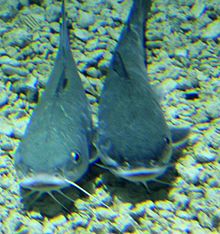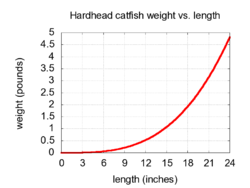Hardhead catfish
| Hardhead catfish | |
|---|---|

| |
| Scientific classification | |
| Domain: | Eukaryota |
| Kingdom: | Animalia |
| Phylum: | Chordata |
| Class: | Actinopterygii |
| Order: | Siluriformes |
| Family: | Ariidae |
| Genus: | Ariopsis |
| Species: | A. felis
|
| Binomial name | |
| Ariopsis felis (Linnaeus, 1766)
| |
| Synonyms[2] | |
| |
The hardhead catfish (Ariopsis felis) is a species of
Habits, distribution, and characteristics

Hardhead catfish are found mostly in the near-shore waters of the Western Atlantic Ocean, around the southeast coast of the United States, around the Florida Keys and the coast of the Gulf of Mexico.[4][5] Hardhead catfish are also found in brackish estuaries and river mouths where the bottom is sandy or muddy,[6] but only occasionally enter freshwater.[1] It tends to move from shallower to deeper waters in the winter months.[7] The species is generally common to abundant within its range.[1]
The hardhead catfish has four
Feeding behavior
A. felis consumes a wide range of food. It is an
Its diet depends on its size and location. Younger hardhead catfish tend to eat small
Locomotion
Significant evidence suggests correlation between the fish's activity patterns and seasonal changes. Under controlled conditions of
Communication
Chemical
Hardhead catfish respond to chemicals released by injured individuals with increased activity, illustrating communication among catfish. Their activity level was highest right after the onset of the chemical stimulus. They also respond to chemical cues from injured sailfin mollies, but this response was weaker than that of the response from their own species. After examining the epidermis of the hardhead catfish, the alarm substance cells apparently were similar to those of freshwater catfish. These chemical responses had only been seen in freshwater ostariophysans. Hardhead catfish are the first marine ostariophysans found to elicit this type of alarm reaction.[11]
Echolocation
Furthermore, hardhead catfish are the first indicator that Osteichthyes possibly could use directional hearing to detect obstacles. Emissions of low-frequency sounds were related to the detection and avoidance of close obstacles. Individuals within the group that produced sound avoided obstacles, whereas silent individuals crashed into obstacles frequently. Many fish have been associated with sound production for alarm, territorial, and courtship purposes, but sound probing of surroundings seems to be only be seen in hardhead catfish. So far, no evidence exists for far-field echolocation, such as seen in bats or toothed whales. The signal parameters have low frequency and amplitude, so far-field reverberations are unlikely to be useful. If echolocation exists, it is likely only useful in the near field by the catfish.[12]
Sound production
Some evidence indicates sound production in hardhead catfish is differentiated both mechanistically and contextually. Mechanistically, sound can be produced in different ways. Thin bones by the
Lifecycle and reproduction
The hardhead catfish has a reproductive season from around May to September.
Parental care
Mouthbrooding
Like other members of the
Advantages
Many advantages to mouthbrooding exist as opposed to other forms of parental care, such as bubble nesting. Mouthbrooders are able to freely move with the eggs in their mouths, thus can move as necessary to protect both themselves and the broods. Though mouthbrooding requires more energy by the male, the chance of his young surviving to adulthood is greater, thus reproducing and continuing his genes; the eggs are not defenseless while in their father's mouth.[17] Mouthbrooding by males counters the relatively low fecundity of females, which only have 20-65 eggs per spawning episode.[8] Finally, through breathing, the male is able to keep the brood well oxygenated, which also increases brood survival.[17]
Fishing
Hardhead catfish are voracious feeders and will bite on almost any natural bait. Hardhead catfish are also known to steal bait. Shrimp is a particularly effective bait to use. When fishing for this species in fresh water, assorted meats tend to work best as bait. For example: bacon, chicken, cuts of steak, and smaller fish. Hardhead catfish are generally regarded as an undesirable catch by most anglers, largely due to the risk associated with handling the venomous fish, as well as its 'fishy' taste as opposed to desirable game fish. Hardhead catfish are edible, but like all catfish, require some effort to clean. It is one of the 30 most recreationally harvested species in the five-county area (Volusia, Brevard, Indian River, St. Lucie, Martin) encompassing the Indian River Lagoon in central Florida.[8] From 1997 to 2001, 361,022 hardhead catfish were harvested within 200 miles of the shore in the IRL region.
Hardheads are also harvested for industrial purposes in commercial bottom-trawling operations. Annual harvests vary greatly, but from 1987 to 2001, 1.04 million pounds of marine catfishes (including both the hardhead catfish and the gafftopsail catfish) were harvested in the IRL region. The harvest was valued at $777,497.[8]
Weight and length

Hardhead catfish weigh around 1 lb (0.45 kg) and measure 10 to 12 in (25–30 cm) long.
As hardhead catfish grow longer, they increase in weight. The relationship between length and weight is not linear. The relationship between total length (L, in inches) and total weight (W, in pounds) for nearly all species of fish can be expressed by an equation of the form:
Invariably, b is close to 3.0 for all species, and c is a constant that varies among species. The relationship described in this section suggests that a 20 in (51 cm) hardhead catfish will weigh about 3 lb (1.4 kg), while a 25 in (64 cm) hardhead catfish will likely weigh at least 6 lb (2.7 kg).
References
- ^ . Retrieved 19 November 2021.
- ^ "Ariopsis felis (Linnaeus, 1766)". World Register of Marine Species. Retrieved 28 July 2017.
- ^ Froese, Rainer and Pauly, Daniel, eds. (2017). Species of Ariopsis in FishBase. February 2017 version.
- ^ a b Webster, Pearse. Hardhead Catfish. South Carolina Department of Natural Resources. http://www.dnr.sc.gov/cwcs/pdf/Hardheadcatfish.pdf
- ^ a b Froese, Rainer; Pauly, Daniel (eds.) (2017). "Ariopsis felis" in FishBase. February 2017 version.
- ^ "Hardhead Catfish_ Arius felis".
- ^ "Hardhead Catfish_ Arius felis".
- ^ a b c d e f g h i j k l Hill, K. "Ariopsis felis". Smithsonian Marine Station at Fort Pierce. Retrieved 1 October 2013.
- ^ .
- JSTOR 1541518.
- )
- PMID 23741408.
- ^ "Hardhead Sea Catfish". Discovery of Sound in the Sea. Retrieved 1 October 2013.
- ^ .
- ^ PMID 28563416.
- ^ Jones, P.W., F.D. Martin, J.D. Hardy Jr. (1978). Development of fishes of the mid-Atlantic Bight: an atlas of egg, larval, and juvenile stages. Volume I: Acipenseridae through Ictaluridae. Ft. Collins, CO: U.S. Fish and Wildlife Service, Office of Biological Programs.
{{cite book}}: CS1 maint: multiple names: authors list (link) - ^ a b Hellweg, Mike. "I've Got a New Mouthbrooding Betta-Now What?". Species Maintenance Program. Retrieved 2 October 2013.


